Special Feature: Products Sally Recommends
Exploring Vietnam in Luxury: Part 1
"Room Service? This is Suite number 407. Could you please send up some Beluga Caviar?" Five minutes later a petite German Stewardess arrives with a large silver tray bearing a sizeable dish of these Caspian pearls, together with the usual accompaniments, placing them on the table in the lounge of our luxurious shipboard suite. A scene from a Hollywood movie? No, this is real life, and in the last place in the world where you would expect such a scenario -- the Harbor of Ho Chi Minh City.
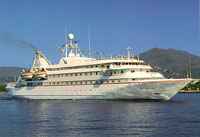 On boarding the Sea Goddess in Bangkok Harbor we can't help thinking that this vessel could be taken for a luxury yacht belonging to a King or Mega-millionaire. The sleek high-tech lines, obvious elegance, and a size closer to a super-yacht than a large cruise ship, are tantalizing hints of the splendor to be found on board during our ten day cruise along the coast of Vietnam and on to Hong Kong. There aren't many ships afloat today where you can call up Beluga Caviar, (three or four times a day if that is what you fancy) and have no extra charge on your bill at the end of the cruise. But the Sea Goddess is one of the few where that is the case.
On boarding the Sea Goddess in Bangkok Harbor we can't help thinking that this vessel could be taken for a luxury yacht belonging to a King or Mega-millionaire. The sleek high-tech lines, obvious elegance, and a size closer to a super-yacht than a large cruise ship, are tantalizing hints of the splendor to be found on board during our ten day cruise along the coast of Vietnam and on to Hong Kong. There aren't many ships afloat today where you can call up Beluga Caviar, (three or four times a day if that is what you fancy) and have no extra charge on your bill at the end of the cruise. But the Sea Goddess is one of the few where that is the case.
Prior to sailing we had received a questionnaire from Captain Sven Erik Pedersen. Would we like twin beds or a queensize bed in our stateroom? Did we have any requests for specific outings at the various destinations? Were there any special meals or dishes we would like prepared? Perhaps a salt-free diet? What category of reading matter would we like in our bookshelves? What favorite liquor (complimentary, of course!) would we like in the private bar of our suite?
Arriving at the top of the gangway steps, we are welcomed by the smiling purser. While he greets us, stewards bring champagne, and the ladies are presented with a long stemmed rose. Then we are introduced to our charming stewardess who is to attend to our cabin requirements, from round-the-clock room-service meals to setting the T.V. for videotext or cassette films.
Our suite can only be called ultra-luxurious. The bedroom is separated by a curtain from the lounge, which holds a two-metre settee, crystal glasses in the bar, a coffee/dining table and a telephone from which worldwide direct dialing via satellite makes every corner of the world accessible. There is also an electronic security safe, individual climate control and a bar/refrigerator which is restocked daily. Needless to say, our ultra-modern bathroom has every amenity, an unusual amount of space (so rare on ships) and both a tub and shower. As we go back up to the Lounge, the ship casts off from the wharf. We are on our way to explore Vietnam in style.
Soon the urban chaos that is Bangkok is behind us. Now we are heading downstream, passing rusty the freighters and heavily-laden rice barges that are the workhorses of this river system. Classically narrow and super-long speed boats, spraying water from their long-shafted propellers, race up and down the river. They carry brightly clad women clutching umbrellas to keep off the summer sun, contrasting with saffron robed monks with shaven heads, on their way to visit temples to pray or houses to receive the food donations on which they live.
The Chao Phray River is not only the major highway of this region, but also the very essence of this part of South-East Asia. Luxurious vegetation alternates with bustling townships and villages. Graceful temples, their gold leaf encrusted stupas and orange, green, black and gold tiles glinting in the setting sun, visually convey the very soul of Thailand.
 But for those on board it's now time to change for dinner. Before we go into the dining room, cocktails are served in the ship's stylish Lounge while Scottish singer, Stuart Gilles, entertains us with his melodious voice and lyrical songs. Lovely!
But for those on board it's now time to change for dinner. Before we go into the dining room, cocktails are served in the ship's stylish Lounge while Scottish singer, Stuart Gilles, entertains us with his melodious voice and lyrical songs. Lovely!
Dinner is an elegant, leisurely, though still somewhat formal silver service affair -- one sitting from 7.30p.m. - 10.00p.m. with other guests of your choice -- so avoiding the unpleasant vibes caused by being seated with incompatible company and the rush of double sittings so common on many ships.
Menus are of the standard you would expect in top-class international restaurants in Paris or New York. Premium wines, such as Chateau de Chantegrive 1994 from Graves and Chianti Classico Fattoria Reseccoli 1992 from Tuscany, are all-inclusive, and we also notice that a number of the guests order their own favorite dishes two or three days ahead. Two couples at our table who are regular Sea Goddess travelers (eighty percent of all first-time passengers will come back again) do this, and are rarely disappointed.
During dinner a pianist plays soft music on a baby grand piano, the black surface of which reflects a bowl of long-stemmed pink roses, which somehow exactly match the color of the tablecloths and decor in the dining room. Dinner Menus offer Appetizers like Japanese Sushi with Wasabi and Shiitaki Sauce, Salad Caprese with Balsamico Vinaigrette, Spaghettini "Arabiata." A selection of soups offer a choice of Chicken Consomme with Won Ton, Cream of Asparagus and Chilled Plum Flip.
Main courses consist of a selection from Grilled Sirloin Steak with Glazed Shallots and Pommes Macaire, Whole Roasted Veal Loin with Marsala Sauce and Thyme Gnocchi, Stuffed Woodland Quail with Shoestring Potatoes and Sauce Perigordine. Choices of healthy salads are also offered daily.
Alternate Asian and vegetarian dishes are also available, as is a three-course "Golden Door" meal that is high on taste but low on calories. Desserts offer selections from Mocha Souffle with Baileys Sauce, Cassis Parfait with Tropical Fruit, Raspberry Pie, Fruit Sherbets and various Ice Creams. And if all that isn't enough, the Cheese Platter is "formidable" and the coffee excellent. No wonder you can watch your clothes shrink daily!
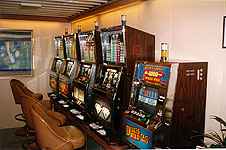 Dinner over, it is a matter of mood whether we adjourn to the lounge for more dancing and drinks, head for the casino to watch considerable sums change hands at blackjack, or sit in the library for a little backgammon or a game of Trivial Pursuit. On other nights we will choose a book or video cassette to enjoy in the privacy of our comfortable suite. The next day is spent at sea -- a marvelous opportunity to meet and get to know the other passengers, fully explore the ship and generally settle in.
Dinner over, it is a matter of mood whether we adjourn to the lounge for more dancing and drinks, head for the casino to watch considerable sums change hands at blackjack, or sit in the library for a little backgammon or a game of Trivial Pursuit. On other nights we will choose a book or video cassette to enjoy in the privacy of our comfortable suite. The next day is spent at sea -- a marvelous opportunity to meet and get to know the other passengers, fully explore the ship and generally settle in.
We notice the little touches. The ship receives international news bulletins relevant to the citizens of every country. The staff know that we are from Australia, so the satellite news sheets we get daily not only cover world events, but also some pages of specifically Australian information that ranges from the stock market to local news, politics and the great Australian icon -- sport. The British, Americans, Germans, South Africans and so on, who are on board get similar on their own country's happenings. That's true "class!"
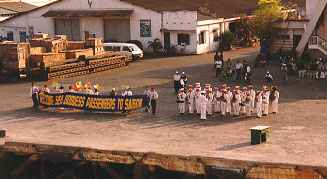
As we pull into Saigon Harbor (nobody bothers to call this by its official name of Ho Chi Minh City) a school band, their instruments brightly polished for the occasion and with the youngsters dressed in their Sunday-best uniforms, awaits us. No-one can tell me that the Vietnamese don't have a sense of humor! Moments into the first melody, the teenage trumpeter's instrument "freezes," turning the sound into a good replica of a braying donkey in heat.
That does it! Within seconds, the rest of the orchestra have stopped playing and are literally doubled-up with laughter. We all join in on the laughter, and at this point the trumpeter, till then red faced and hugely embarrassed, also sees the funny side and joins the hilarity. It is far better and more spontaneously ground-breaking than if that band had played faultlessly.
Disembarking, we board buses and are driven through the city to attend a Cultural Reception in the Palace that had been built for an earlier South Vietnamese President. The ride through Saigon is impressive, as is the city itself. I had been unaware that this city now has an official population of five million with an extra two million unofficial "visitors." Nor am I prepared for the amount of Westernization that is evident.
A particularly poignant moment brings a lump to my throat as we pass a spot I have seen in newspapers and television what seems like a million times. We are passing the walled-off shell of the old American Embassy that stands, starkly abandoned, with the helicopter pad and outside staircase that was the very symbol of those last days of the Vietnam War, when a shuttle of U.S. helicopters were evacuating thousands from this very spot, taking them to the U.S. Fleet moored a few miles offshore.
The Americans have certainly left an indelible mark on Saigon, affecting the people's tastes, values and attitudes to a degree that no amount of Viet Cong indoctrination can erase. Today, a spirit of Capitalism and free-enterprise prevails. Those inhabitants who are not lucky enough to have relatives sending a constant flow of money from overseas find it difficult to make a living. Those who manage do so, hold down two, or sometimes even three, jobs. For them, life wasn't meant to be easy.
The city has been fully rebuilt, and all signs of the war have gone. It is hard to imagine that five hundred thousand Americans fought in Vietnam against three million North Vietnamese soldiers and lost sixty thousand men in the process. If Vietnamese figures are to be believed, the Vietnamese lost three million dead and had four million wounded. Now the city looks like most Asian equivalents. We would see evidence of how the Vietnamese were affected when we later visited the War Museum.
The Palace Reception is a classic Communist-country one, with excellent hors d'oeuvres and an interesting cultural show of local instruments and dancers, but not enough chairs so that half the guests have to stand. Then follows a tour which, because of its historic significance, to me is the highlight of the evening. A guide takes us down into the basement of the Palace which contains the South Vietnamese Presidential Command HQ and Briefing Rooms used during the dark days of the Vietnam War. What dramas were played out in these concrete-reinforced basement bunkers? What frustrations and emotions were pent up, or perhaps released here as the fortunes of that period flowed and ebbed? If only these walls could talk!
After returning to the ship for late dinner, we spend the next morning again touring Saigon. There really is no proper tourist infrastructure in this city as yet. The Vietnamese are far more interested in getting their manufacturing industries upgraded to Western standards and are not all that experienced -- or financial -- to be able to set-up a tourist infrastructure equivalent to that of cities like Singapore, Hong Kong or similar. But they are aware of the potential and new hotels and other tourist-related projects are coming on-stream every month.
We visit the War Museum, still officially classified as the Museum of American War Atrocities. The displays are certainly horrific in parts and show the real horrors of war. But the way the captions are presented reminds me of Russian propaganda during the Cold War days -- the Americans are exclusively sadistic villains and the Vietnamese are, to a man and woman, saints. It never ceases to amaze me to what extent propagandists of any persuasion lose track of the fact that not all viewers of their displays are either totally na‘ve or congenital idiots!
Originally laid out by the French, Saigon seems to be very much under the influence of western capitalist values. Motorbikes are everywhere, there is no shortage of cars, shops are full of Japanese electronics, and billboards proclaim the virtues of everything from Motorola mobile phones to Coca Cola, Hitachi and National electricals, Honda motorbikes and Compaq computers.
The Museum of National History is next -- quite unimpressive with poor displays showing little French or English wording, and again with too heavy an emphasis on propaganda. Yet it does map out the plight this nation has been subjected to, being under Chinese domination for one thousand years of its four-thousand-year history and then under French domination for the century from the late 1800s to the late 1900s. The French influence is still there, though not nearly as great as we were later to see in Hanoi. My main impression of this is of the Post Office, built by the French at the end of the 1800s and designed by Ferdinand Eiffel of Tower fame.
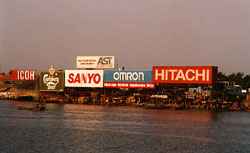
The Vietnamese are extremely adaptable, hard-working people and much of the wealth we see displayed by cars, motorbikes and electrical goods is, according to our guide, the result of remittances from the huge number of emigrants who are sending back money from U.S.A., Australia, Canada or Britain to the family members they have left behind.
I had not realized the vast distance from Saigon -- oops -- Ho Chi Minh City to Hanoi until I see that we will need a whole day at sea to cover the stretch to Nha Trang, a fishing port not far from the former capital of North Vietnam. The full day on the ship is far from boring. It gives us the opportunity of fully exploring and enjoying our floating luxury hotel.
Again, we cannot fail but be impressed with the superb cuisine on the ship. A Austrian Executive Chef, German pastrycooks, British breakfast creators and excellent Asian cooks make the ship's food brigade a true United Nations. Breakfast is served alfresco on the sunny deck and is extensive as well as informal.
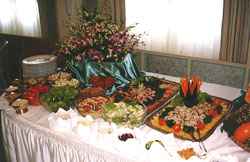 And what breakfasts! The day's opening meal on the "Sea Goddess" offers a choice of buffet or a la carte, where guests can have almost any dish cooked to order. Most, however, choose from the well-stocked deckside buffet -- fruit juices, fresh fruit, muesli with every conceivable topping from dried fruit to toasted nuts, fruit salad, croissants, eight different types of fresh bread baked overnight in the ships bakery, jams, a huge range of cheeses. As well as this the breakfast chef is there to prepare steaks, sausages, bacon, eggs cooked in any way, fried, grilled or poached fish, waffles, pancakes or anything else a guest may fancy that morning.
And what breakfasts! The day's opening meal on the "Sea Goddess" offers a choice of buffet or a la carte, where guests can have almost any dish cooked to order. Most, however, choose from the well-stocked deckside buffet -- fruit juices, fresh fruit, muesli with every conceivable topping from dried fruit to toasted nuts, fruit salad, croissants, eight different types of fresh bread baked overnight in the ships bakery, jams, a huge range of cheeses. As well as this the breakfast chef is there to prepare steaks, sausages, bacon, eggs cooked in any way, fried, grilled or poached fish, waffles, pancakes or anything else a guest may fancy that morning.
I talk to the ship's Executive Chef, Anton Schraivogl, who trained in Austria and Switzerland before coming on to the Sea Goddess, to ask him how difficult it is to provision the Sea Goddess in out-of-the-way ports.
"We have very large refrigerated coolrooms," he answers. "I order the meat air-freighted from U.S.A., salmon from Scotland or Scandinavia and the other produce from whatever country we require. That gets flown in and is waiting for us at major ports. Then the ship's agents procure local fruits and vegetables as well as whatever other fresh produce is available to supplement these imports. We build our menus around the art of the possible but make sure that the quality standard is never lowered." That is very obvious from all the meals we have on the ship.
Our next landfall will be Nha Trang. We had been disappointed when we saw that we were going to spend time at what we thought would be a deadly boring fishing port. As it turns out, Nha Trang will be a highlight, mainly due to the people we will meet there. But that will be in Part 2 of the story of this cruise which will then take us to Hanoi and on, past the Chinese mainland to Hong Kong.
![]()
Resources
The Sea Goddess offers several annual cruises to Vietnam, usually in early February. For further details ask your Travel Agent to get you a brochure on these vessels' itinerary from the famous Cunard Line. There are two identical Sea Goddess ships and both offer fascinating itineraries to some wonderfully, out-of-the-way ports and places. If you cannot get a brochure through your Travel Agent, fax Cunard at their New York Office, fax number 1.212.945.0915.
Note: This information was accurate when it was published. Please be sure to confirm all rates and details directly with the businesses in question before making your plans.



